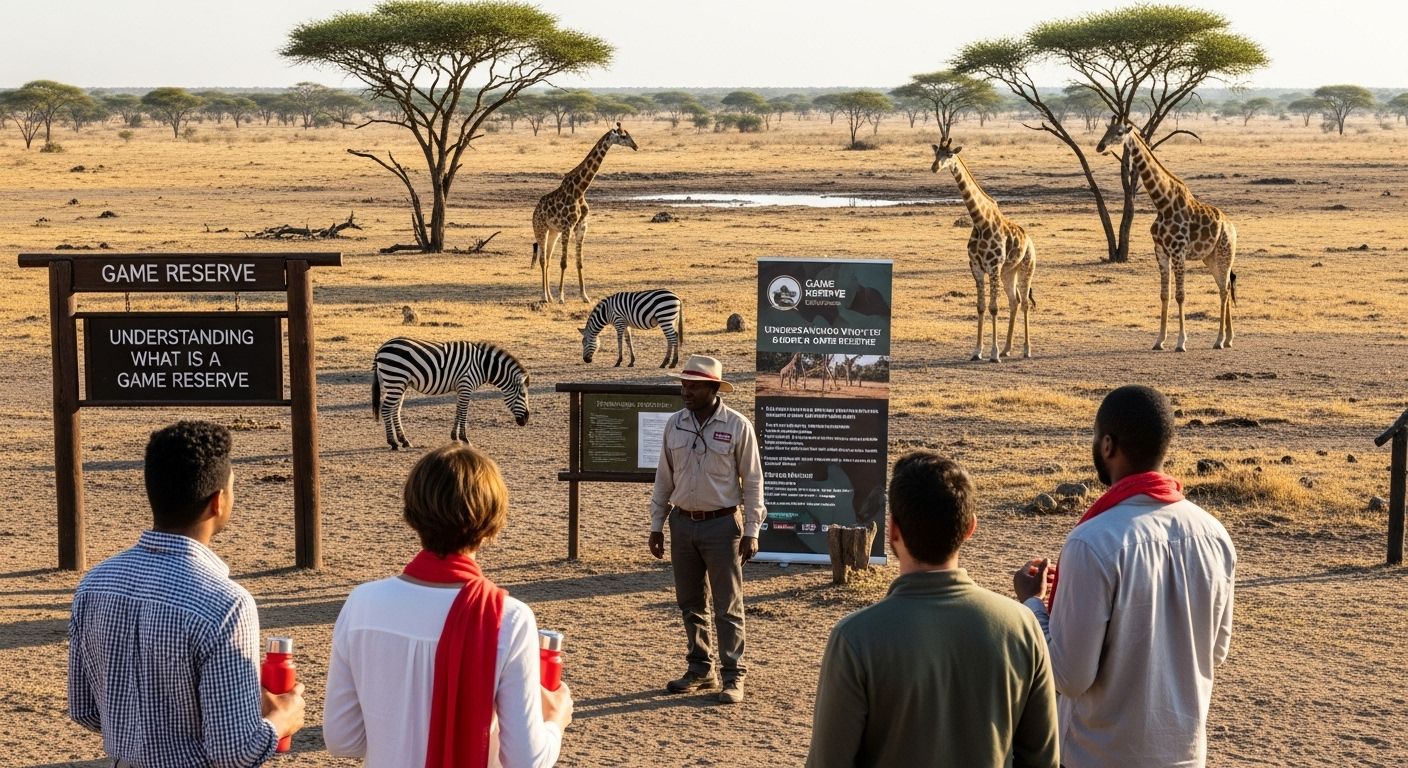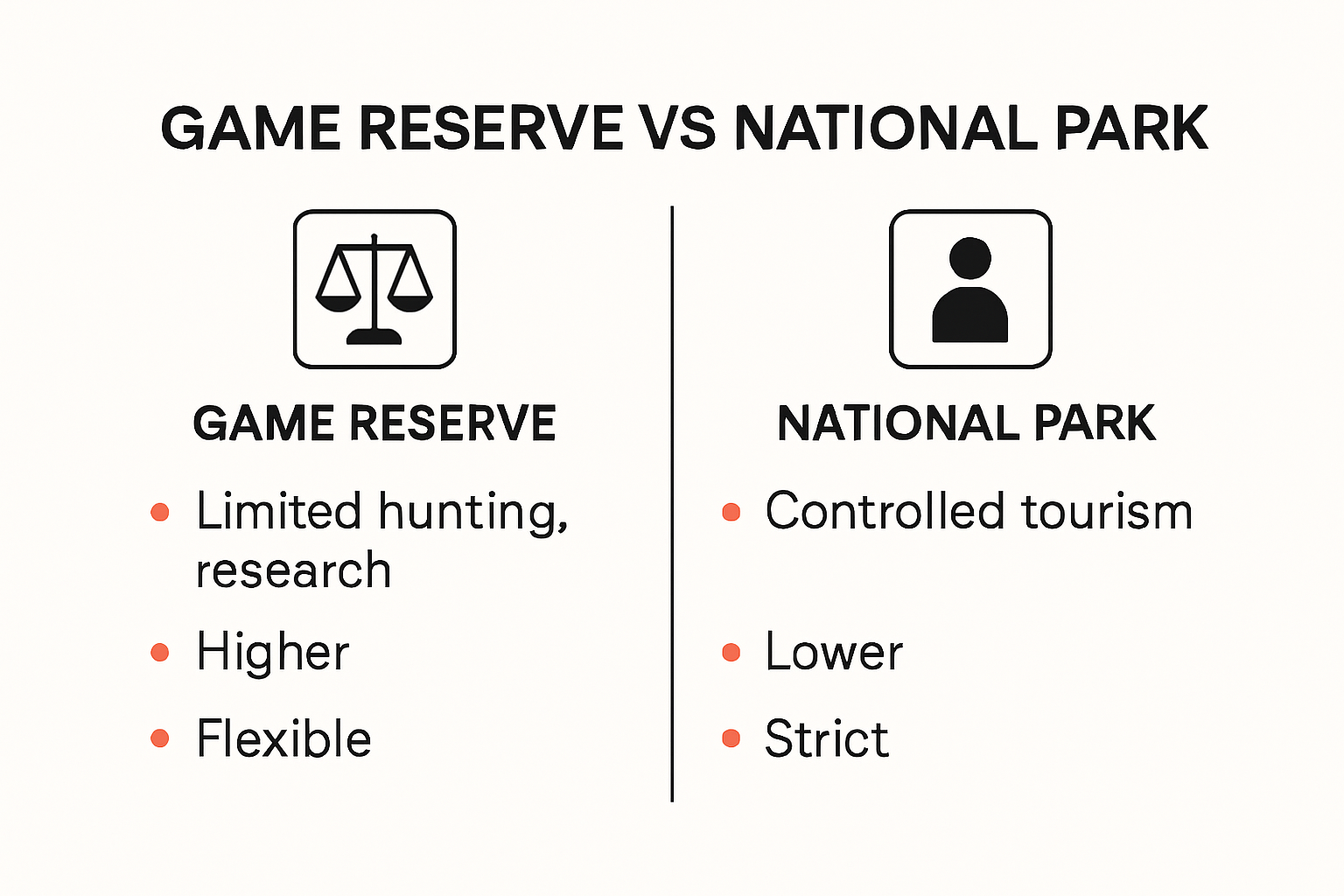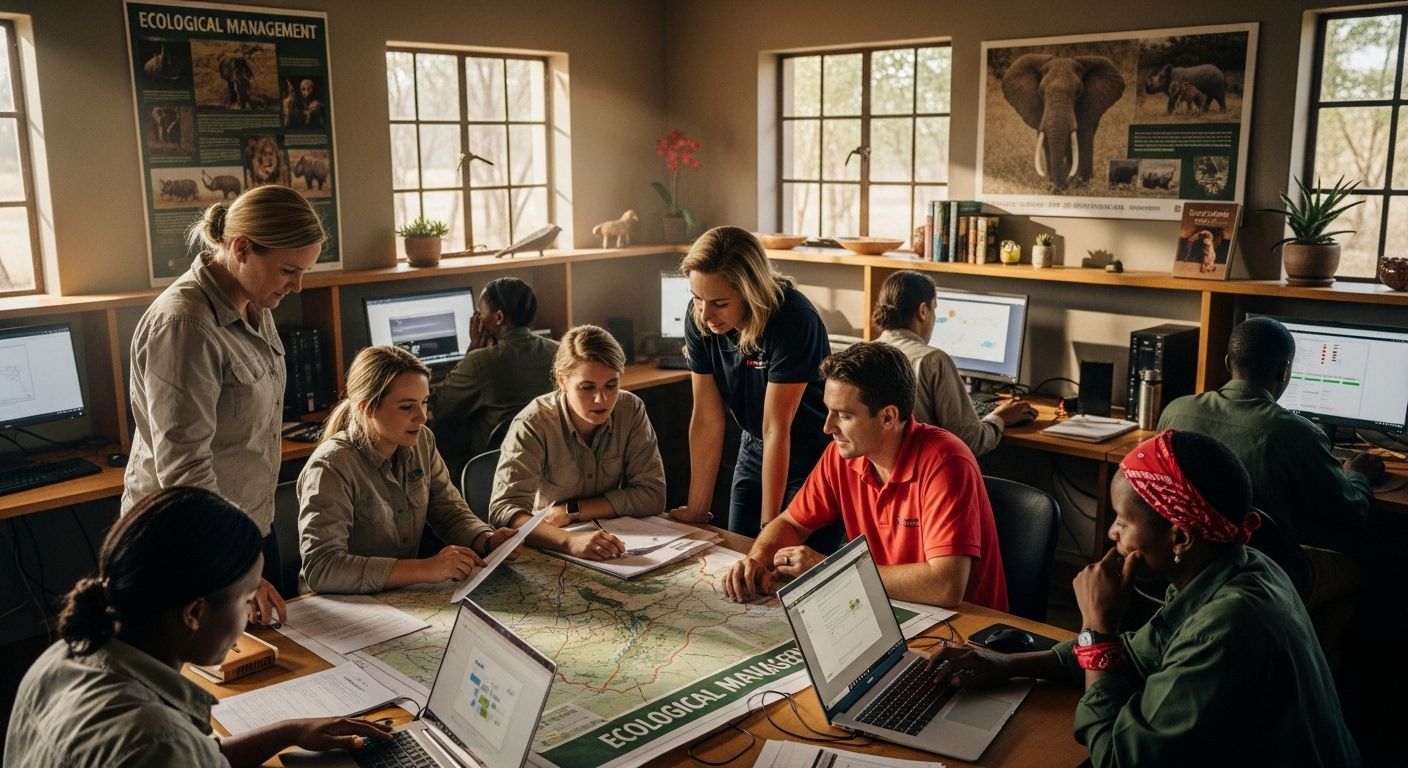Understanding What is a Game Reserve and Its Significance
Full Disclosure: Our AI Assistant Writes These!
While we're out in the bush tracking leopards, dodging elephants, and trying to get the perfect sunset shot, our trusty AI companion is back at camp, diligently crafting these blog posts. Don't worry though - it's been trained on years of real safari experiences and only occasionally suggests that tourists should pet the lions. (Please don't pet the lions. The AI was joking. We hope.)
The real reason? SEO loves fresh content, and we love fresh adventures. So while our AI handles the keywords and search rankings, we're out there finding the next hidden waterhole, secret viewpoint, or that one tree where the leopards always hang out. Win-win, really!
Understanding What is a Game Reserve and Its Significance
Game reserves are not just patches of wilderness fenced off for animals. These areas protect staggering biodiversity, with over 80 percent of Africa’s threatened species finding sanctuary in such reserves.

You might think all wildlife areas are pretty much the same, just with different names. The real difference is how game reserves balance strict conservation with hands-on management and allowed human activity, turning them into dynamic hubs for both protection and participation.
Table of Contents
- Defining A Game Reserve: Key Characteristics And Purpose
- The Importance Of Game Reserves In Wildlife Conservation
- How Game Reserves Operate: Structure And Management
- Experiences In Game Reserves: What To Expect For Travelers
- Challenges Faced By Game Reserves And Future Directions
Quick Summary
| Takeaway | Explanation |
|---|---|
| Game reserves protect biodiversity. | They create safe havens for vulnerable species and preserve natural habitats from degradation. |
| Sustainable tourism supports conservation. | Controlled tourism generates funding for reserves while promoting ecological awareness among visitors. |
| Regulations guide human interactions. | Legal frameworks establish strict rules on hunting and wildlife management to balance conservation and human activities. |
| Game reserves serve as ecological laboratories. | These areas allow for the study of ecosystem dynamics, supporting scientific research and effective conservation strategies. |
| Conservation requires community involvement. | Engaging local communities is essential for balancing conservation goals and socio-economic needs, ensuring sustainable management. |
Defining a Game Reserve: Key Characteristics and Purpose
A game reserve represents a protected natural area specifically designated for wildlife conservation, habitat preservation, and sustainable ecological management. Unlike traditional national parks, game reserves offer a unique approach to protecting biodiversity while allowing controlled human interaction and wildlife management.
Understanding the Core Purpose
The primary objective of a game reserve is to create a sanctuary where wildlife can thrive with minimal human interference. Discover our comprehensive guide on wildlife conservation to understand the broader context of these critical ecosystems. These reserves serve multiple critical functions:
- Protect endangered species and their natural habitats
- Maintain ecological balance and biodiversity
- Support scientific research and environmental monitoring
- Enable sustainable wildlife management practices
Game reserves differ from other protected areas by offering more flexible management strategies. They typically permit limited hunting, research activities, and controlled tourism, which helps generate funding for conservation efforts while maintaining ecological integrity.
To help distinguish between different types of protected areas, here is a comparison of game reserves and national parks as described in the article:
| Feature | Game Reserve | National Park |
|---|---|---|
| Main Purpose | Wildlife conservation, habitat preservation, sustainable management | Conservation and public enjoyment |
| Human Interaction | Controlled, may allow limited hunting and research | More restricted; generally no hunting allowed |
| Tourism | Controlled and limited to support conservation funding | Managed, typically higher visitor numbers |
| Management Flexibility | More flexible; adaptive strategies for ecology and economy | Usually stricter management set by law |
| Legal Framework | Specific regulations for hunting, research, and tourism | Governed by broader national or international laws |

Legal and Ecological Framework
According to the Library of Congress wildlife conservation guidelines, game reserves are legally established territories with specific regulations governing human interaction and wildlife protection. These areas are meticulously planned to balance conservation needs with sustainable ecological practices.
The legal framework surrounding game reserves typically includes:
- Strict regulations on hunting and wildlife interaction
- Controlled access for researchers and limited tourism
- Comprehensive wildlife population management strategies
- Ongoing habitat restoration and preservation initiatives
By creating these specialized zones, conservation experts can implement targeted strategies to protect vulnerable species, monitor ecosystem health, and promote biodiversity preservation. Game reserves represent a sophisticated approach to wildlife management, bridging the gap between human interests and natural ecosystem preservation.
The Importance of Game Reserves in Wildlife Conservation
Game reserves play a pivotal role in protecting and preserving vulnerable ecosystems, offering far more than simple land demarcation. These specialized areas serve as critical sanctuaries that enable comprehensive wildlife conservation strategies and sustainable ecological management.
Biodiversity Protection and Species Preservation
Biodiversity conservation represents the cornerstone of game reserves’ significance. Learn more about conservation strategies for travellers to understand their global importance. According to the U.S. Forest Service research, these reserves provide essential habitats that support endangered species and help maintain complex ecological networks.
Game reserves contribute to biodiversity protection through:
- Creating safe havens for vulnerable animal populations
- Preventing habitat fragmentation
- Supporting genetic diversity within species
- Enabling natural breeding and migration patterns
Ecological Balance and Ecosystem Management
Beyond individual species protection, game reserves play a crucial role in maintaining broader ecosystem health. They function as living laboratories where complex ecological interactions can be studied, monitored, and preserved. By establishing controlled environments, conservation experts can implement targeted interventions that support natural regeneration and prevent ecosystem collapse.
Key ecosystem management strategies include:
- Monitoring population dynamics
- Controlling invasive species
- Restoring degraded habitats
- Implementing sustainable resource management
These carefully designed reserves represent sophisticated approaches to conservation, bridging scientific understanding with practical ecological preservation. They demonstrate how strategic human intervention can support and enhance natural systems, ensuring the long-term survival of diverse wildlife populations and maintaining the intricate balance of our planet’s most vulnerable ecosystems.
How Game Reserves Operate: Structure and Management
Game reserves represent complex ecological systems requiring sophisticated management strategies that balance conservation objectives with sustainable ecological practices. These protected areas demand intricate planning, continuous monitoring, and strategic interventions to maintain their ecological integrity and wildlife populations.
Governance and Administrative Framework
Institutional management forms the foundation of game reserve operations. Learn more about sustainable wildlife management approaches to understand the comprehensive strategies involved. According to the National Wildlife Refuge System guidelines, effective game reserve management involves multiple stakeholders and comprehensive governance structures.
Typical administrative components include:
- Establishing clear legal boundaries and protection mandates
- Developing comprehensive conservation management plans
- Creating interdisciplinary management teams
- Implementing robust monitoring and reporting systems
Ecological Management and Intervention Strategies
Game reserves employ nuanced ecological management techniques that go beyond simple land preservation. Conservation experts utilize scientific methodologies to understand and support complex ecosystem dynamics. These strategies involve precise interventions designed to maintain natural balance while addressing potential ecological challenges.
Key ecological management approaches encompass:
- Population control and demographic monitoring
- Habitat restoration and rehabilitation
- Managing human-wildlife interactions
- Implementing targeted conservation interventions
By integrating scientific research, technological monitoring, and adaptive management techniques, game reserves create dynamic ecosystems that can respond to changing environmental conditions. These carefully designed systems demonstrate how strategic human intervention can support and enhance natural processes, ensuring the long-term survival of diverse wildlife populations and maintaining the delicate balance of complex ecological networks.

Experiences in Game Reserves: What to Expect for Travelers
Game reserves offer travelers extraordinary opportunities to immerse themselves in pristine wilderness environments, providing unique encounters with wildlife and authentic conservation experiences. These remarkable destinations transform traditional tourism into meaningful ecological interactions that educate and inspire visitors.
Wildlife Observation and Interaction Guidelines
Responsible wildlife viewing requires understanding specific behavioral protocols and safety considerations. Discover the ultimate safari experience guide to prepare for your adventure. According to the U.S. Fish & Wildlife Service guidelines, travelers must prioritize wildlife safety and environmental respect during their reserve experiences.
Key wildlife observation principles include:
- Maintaining safe and respectful distances from animals
- Using quiet observation techniques
- Following professional guide instructions
- Minimizing environmental disruption
Recreational and Educational Opportunities
Game reserves transcend traditional tourism by offering multifaceted experiences that combine adventure, education, and conservation awareness. Travelers can engage in diverse activities designed to foster deeper understanding of ecological systems and wildlife conservation.
Typical visitor experiences encompass:
- Guided safari tours with expert naturalists
- Photography workshops focusing on wildlife
- Environmental education programs
- Sustainable tourism interactions
These carefully curated experiences ensure that travelers not only witness extraordinary wildlife but also contribute to broader conservation efforts. By participating in game reserve activities, visitors become active participants in global biodiversity preservation, transforming their travel experiences into meaningful environmental engagement.
Challenges Faced by Game Reserves and Future Directions
Game reserves stand at a critical intersection of environmental preservation, socioeconomic development, and complex ecological challenges. These protected areas face unprecedented pressures that demand innovative solutions and strategic interventions to ensure their long-term sustainability and effectiveness.
Environmental and Ecological Threats
Biodiversity preservation confronts multiple systemic challenges that threaten the fundamental integrity of game reserves. Explore our comprehensive wildlife conservation strategies to understand the evolving landscape of conservation efforts. According to government environmental policy research, game reserves encounter significant ecological disruptions that require multifaceted management approaches.
Key environmental challenges include:
- Climate change and habitat degradation
- Invasive species disrupting native ecosystems
- Fragmentation of wildlife corridors
- Increasing human-wildlife conflict zones
Socioeconomic and Governance Challenges
Game reserves operate within complex socioeconomic frameworks that extend beyond pure ecological management. These protected areas must balance conservation objectives with local community needs, economic sustainability, and broader national development strategies.
Primary socioeconomic challenges encompass:
- Limited financial resources for conservation
- Competing land-use priorities
- Balancing tourism development with ecological preservation
- Implementing sustainable community engagement models
The future of game reserves depends on developing holistic, adaptive management strategies that integrate technological innovation, community participation, and sophisticated ecological understanding. By embracing interdisciplinary approaches and recognizing the interconnected nature of environmental preservation, game reserves can transform current challenges into opportunities for meaningful conservation and sustainable development.
Below is a summary table outlining the main challenges faced by game reserves, grouped into environmental and socioeconomic categories for easier understanding:
| Challenge Type | Description |
|---|---|
| Climate Change | Alters habitats, affecting wildlife and ecosystem stability |
| Habitat Degradation | Loss or decline of natural habitats, reducing biodiversity |
| Invasive Species | Non-native species disrupt native flora and fauna |
| Fragmented Corridors | Wildlife movement restricted by barriers and land use changes |
| Human-Wildlife Conflict | Encounters between people and animals increase risk |
| Limited Funding | Insufficient resources for effective conservation management |
| Competing Land Use | Conflicts with agriculture, communities, and development |
| Balancing Tourism | Need to generate income without harming natural environments |
Experience Conservation First-Hand with Africa Awesome
Learning about game reserves reveals just how fragile African wildlife and ecosystems are. Many travellers feel inspired by the importance of habitat protection, yet are unsure how to support true wildlife conservation while searching for an authentic safari. If you want your next adventure to make a real difference, AfricaAwesome.com transforms your travel goals into action.

See wild places like the Kruger and Serengeti through the eyes of passionate conservationists. With Africa Awesome, you do more than just watch from the sidelines. Our carefully designed safari experiences connect you to the heart of Africa’s protected game reserves, offering personalised itineraries, expert local guides, and a transparent booking process focused on ethical travel. Speak with a travel specialist today to begin your journey or start planning straight away on our easy-to-use site. Game reserves need your support now more than ever. Let us help you become part of the conservation story.
Frequently Asked Questions
What is a game reserve?
A game reserve is a protected area specifically designated for wildlife conservation, habitat preservation, and sustainable ecological management, allowing for controlled human interaction with wildlife.
How do game reserves differ from national parks?
Game reserves differ from national parks by offering more flexible management strategies, often permitting limited hunting, research activities, and controlled tourism to generate funding for conservation efforts.
What are the key benefits of game reserves for wildlife conservation?
Game reserves provide safe havens for vulnerable species, maintain ecological balance, prevent habitat fragmentation, and support genetic diversity while enabling research and sustainable resource management.
What challenges do game reserves face today?
Game reserves face challenges such as climate change, habitat degradation, invasive species, human-wildlife conflicts, and the need to balance conservation with local community needs.